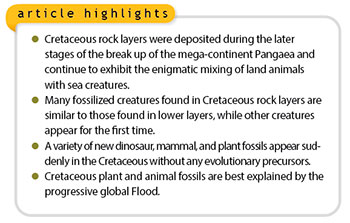 The Cretaceous system of the geologic column, like the other systems below it, is a conundrum to evolutionists because it represents a continuance of many life forms found buried in lower strata combined with one of the most popularized mass extinctions at its conclusion.
The Cretaceous system of the geologic column, like the other systems below it, is a conundrum to evolutionists because it represents a continuance of many life forms found buried in lower strata combined with one of the most popularized mass extinctions at its conclusion.
In addition, many unique types of plants and animals make mysterious sudden appearances in the Cretaceous with no evolutionary precursors. This diverse and unexplained fossil assemblage also coincides with the accelerating final stages of the separation of the former mega-continent Pangaea. However, the evolutionary conundrum of this unique mix of catastrophically buried fossils and violent tectonics is solved by the model of progressive burial by ecological zonation and rapid plate tectonics of the global Flood of Genesis.
Darwin’s Abominable Mystery Begins
Charles Darwin acknowledged that the lack of transitional forms in the fossil record (representing one fundamental type of creature evolving into another) was “a valid argument” against his theory of gradualistic evolution over millions of years.1 Not only were undisputed transitional fossil forms lacking for the animal kingdom, the fossil record for plants was even more problematic and deeply troubled Darwin.
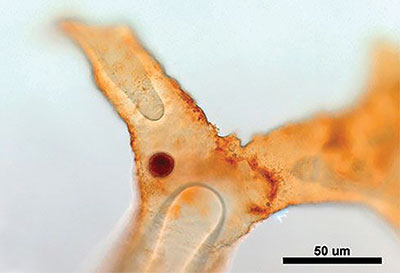
About 20 years after Darwin published his famous book on evolution, he wrote a letter to his personal friend, the famous botanist Joseph Hooker, complaining, “The rapid development as far as we can judge of all the higher plants within recent geological times is an abominable mystery.”2 The chief reason for this abomination is the sudden appearance of many unique kinds of flowering plants (angiosperms) beginning in the Cretaceous—a trend that became even more problematic in higher rock layers.3
Dinosaur Fossils and Soft Tissue Amaze
While dinosaurs are often touted as proof of long evolutionary ages, their mysterious existence and mass burial is actually evidence of creation and the global Flood. As I noted in previous articles in this series, dinosaurs make their first sudden appearance (without evolutionary ancestors) in the Triassic, with even more unique sudden appearances of specialized kinds continuing through the Jurassic and through the Cretaceous.4,5 In fact, the Cretaceous contains many new dinosaur kinds that appear suddenly without evolutionary precursors.6
Perhaps the most well-known dinosaur among the public’s perception is Tyrannosaurus rex (T. rex), which is found in Upper Cretaceous rocks.6 The T. rex was part of a group of dinosaurs known as tyrannosaurids, which were considered to be the largest predators in their various ecosystems. Tyrannosaurids were huge bipedal reptiles with massive skulls filled with large sharp teeth. Despite their immense size, they had large muscular legs that were long and perfectly proportioned for fast movement. In contrast to their back legs, their arms were small with two functional digits. The largest of this dinosaur type was T. rex, which could get over 40 feet in length and up to 8 tons in weight.
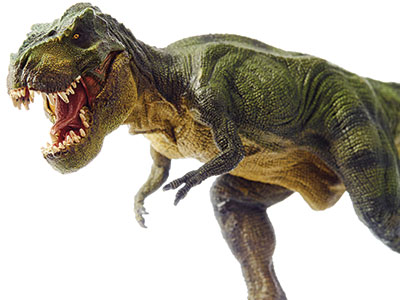
The T. rex has made headlines not only for its unique and imposing appearance but also because its fossils have yielded soft tissue, debunking the idea they lived millions of years ago. A variety of research papers show that T. rex bones contain intact osteocytes (bone cells with intact finger-like extensions), intact blood vessels (with blood cells), and collagen fibers and proteins.7,8 The reason that these tissues, cells, and biomolecules are still present is because these dinosaurs were buried about 4,300 years ago in the Genesis Flood. If they were millions of years old, these features would have degraded.
Another popular dinosaur of the Cretaceous that appears suddenly with no evolutionary ancestors is the Triceratops. This intriguing dinosaur had a unique beak-like mouth and three distinctive horns protruding out of its head, which was framed by a spectacular frill. This imposing creature was a plant-eater up to 30 feet long and weighed 12 tons. Although it was a vegetarian, it had a formidable defense with its horned head and must have been involved in many battles with other dinosaurs, as evidenced by many bite marks and scars in fossil bones that have been discovered (including a bitten- off horn from a T. rex). Like the T. rex, Triceratops fossils have also been found with spectacular examples of soft fibrillar bone tissue that should not be present if these creatures were actually millions of years old as claimed by evolutionists.9
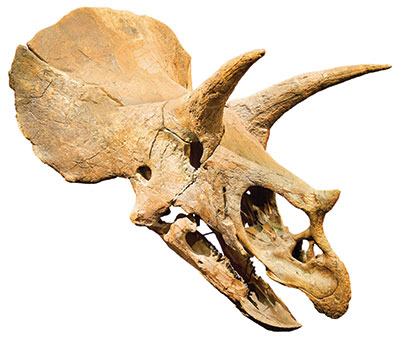
One more example from the Cretaceous is the duck-billed hadrosaur. Hadrosaurids are called facultative bipeds, meaning the younger ones may have walked mostly on two legs while the adults walked mostly on four legs. Their jaws were uniquely designed for grinding and eating plants, with multiple rows of teeth that could replace each other as the older teeth wore down. Hadrosaurs were quite large and could get up to 26 feet in length and weigh up to 4 tons. Not to be outdone by T. rex and Triceratops, hadrosaur fossils have also yielded spectacular soft tissue discoveries, including osteocytes, cartilage, collagen proteins, and chondrocytes (cartilage cells) with chromosomal DNA.10
Mammals and Birds Abound
As I reported in my previous article, mammals were found living alongside dinosaurs in the Triassic and the Jurassic—and the same evolutionary conundrum carries into the Cretaceous, where new mammal types appear suddenly. In fact, Cretaceous fossils have revealed that these various types of mammals were ecologically diverse, exhibiting unique adaptations of gliding, swimming, burrowing, and climbing. This unexpected fossil appearance prompted renowned evolutionary paleontologist David Krause to comment, “The explosion of early-mammal discoveries, particularly from China, over the last two decades has been eye-opening, mind-numbing and absolutely dazzling.”11
Not only do mammals appear suddenly living alongside dinosaurs, but so do birds. A recent fossil discovery in China puts fully avian birds appearing suddenly at the beginning of the Cretaceous.12 Until recently, the oldest Chinese fossil birds from Lower Cretaceous deposits seemed better adapted to climbing or occasional gliding than powered flight. Because only modern-looking bird anatomies were found in Upper Cretaceous rocks, evolutionists believed they had a magic window of about 40 million years for modern-looking birds to evolve. However, that critical window of time has now been shattered with the finding of a fully flying avian fossil in Lower Cretaceous rocks. In other words, fully formed birds appear suddenly alongside dinosaurs without any evidence for dinosaur-to-bird evolution.
Cretaceous-Paleogene Extinction: Smoke and Mirrors
Evolutionary speculation is filled with fanciful tales of repeated mass extinctions, but the evidence is better explained by the global Flood that progressively inundated and buried higher ecosystems as the tsunami-like waters rose. Perhaps the most fanciful and popularized of all these alleged extinction events is at the end of the Cretaceous, known as the Cretaceous-Paleogene (K-Pg) extinction. In this story, we are told about a massive asteroid that hit the earth in Mexico at a site called the Chicxulub crater. This impact supposedly caused a major global cataclysm that selectively led to the demise of the dinosaurs but somehow had no effect on other reptiles, amphibians, mammals, insects, and plants that persisted on into the next geological system (Cenozoic).
While the convoluted story of the K-Pg extinction itself has serious problems, so does the issue of an asteroid impact.13,14 The Chicxulub crater is a semicircular anomaly along the northwestern edge of the Yucatán Peninsula with a diameter of about 110 miles that was supposedly made by a six-mile-wide asteroid or meteorite. It isn’t readily visible because it is covered by younger sediments and is only observed with geophysical methods. However, its validity as a real impact site is negated by a number of serious issues. First and foremost is the fact that it lacks any substantial iridium signature—a hallmark of such impacts. In addition, the so-called “melt layers” are too thin and sparse for an impact of this size. And any high-pressure signatures in the rocks and deformed minerals can also be formed by volcanic eruptions and are not unique to impacts. In reality, the paucity of so-called “circumstantial” evidence can easily be explained by other non-impact processes.
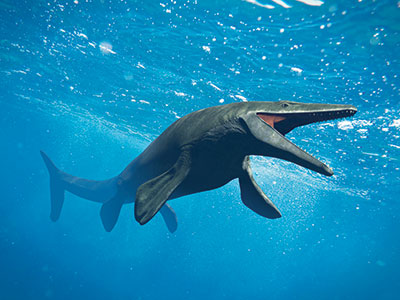
Explaining the Cretaceous Conundrum with the Global Flood
As I mentioned in my previous two articles,4,5 the break up of the pre-Flood mega-continent (called Pangaea) began in the Triassic. The continental separation accelerated in the Jurassic and through the Cretaceous. The Jurassic and Cretaceous also involved the rapid injection of new, hot, buoyant ocean crust forming between the separating continents. Furthermore, the high-water mark for the global Flood most likely occurred during the deposition of the last Cretaceous sediments, which comprise the end of the fifth megasequence known as the Zuni.15 Interestingly, the Zuni also represents a massive increase in the overall amount of sediments being deposited. The average thickness nearly doubles globally from previous megasequences. The deposition of the Zuni likely began about day 100 of the Flood (mid-Jurassic), with the highest water level coming about day 150 (end of the Cretaceous). At this point, the separated continents were completely submerged and all land life was exterminated.
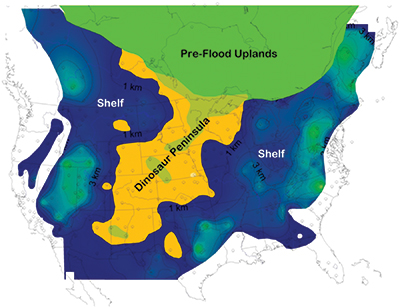
This increasing tectonic activity in the Cretaceous accelerated the violence of the Flood by forcing tsunami-like waves higher and farther inland. The violent action thrust larger marine reptiles (e.g., Mosasaurus), along with deeper-water ocean fish, onto the divided continents, mixing marine with land creatures living at higher elevations. This violent back-and-forth action also transported some land creatures (e.g., dinosaurs) to be buried deep in ocean sediments.15 Land life buried in Cretaceous rocks represents both an increase in water height and depositional violence along with the continuing progressive burial of ecosystems living farther inward.
The Dinosaur Peninsula model developed by ICR scientist Dr. Tim Clarey, which I noted in my previous article, explains their fossil record in the American West from the Triassic through the Jurassic5,15 and continuing through the Cretaceous. In the progressive destruction of the Dinosaur Peninsula, the Cretaceous represented the last massive herds of dinosaurs fleeing the rising floodwaters, which included hadrosaurs, ceratopsians, and tyrannosaurs. And like many land animal fossils, Cretaceous dinosaurs are found mixed with marine creatures. All of this data taken together points directly to the global Flood of Genesis.
Click here for other articles in The Fossils Still Say No series.
References
- Darwin, C. 1859. On the Origin of Species by Means of Natural Selection. London: John Murray, 308.
- Darwin, F. and A. C. Seward. 1903. More letters of Charles Darwin. A record of his work in a series of hitherto unpublished letters. London: John Murray, 20-21.
- Tomkins, J. P. and T. Clarey. 2018. Darwin’s Abominable Mystery and the Genesis Flood. Acts & Facts. 47 (6): 16.
- Tomkins, J. P. 2021. The Fossils Still Say No: Tumultuous Triassic Tussle. Acts & Facts. 50 (7): 10-12.
- Tomkins, J. P. 2021. The Fossils Still Say No: Jostle in the Jurassic. Acts & Facts. 50 (8): 10-12.
- Clarey, T. 2015. Dinosaurs: Marvels of God’s Design. Green Forest, AR: Master Books.
- Schweitzer, M. et al. 2005. Soft-Tissue Vessels and Cellular Preservation in Tyrannosaurus rex. Science. 307 (5717): 1952.
- Schweitzer, M. H., J. L. Wittmeyer, and J. R. Horner. 2010. Soft tissue and cellular preservation in vertebrate skeletal elements from the Cretaceous to the present. Proceedings Royal Society B. 274:183-197.
- Armitage, M. H., and K. L. Anderson. 2013. Soft sheets of fibrillar bone from a fossil of the supraorbital horn of the dinosaur Triceratops horridus. Acta Histochemica. 115 (6): 603-608.
- Bailleul, A. M. et al. 2020. Evidence of proteins, chromosomes and chemical markers of DNA in exceptionally preserved dinosaur cartilage. National Science Review. 7 (4): 815-822.
- Pickrell, J. 2019. How the earliest mammals thrived alongside dinosaurs. Nature. 574: 468-472.
- Wang, M., Z. Li, and Z. Zhou. 2017. Insight into the growth pattern and bone fusion of basal birds from an Early Cretaceous enantiornithine bird, Proceedings of the National Academy of Sciences. 114 (43): 11470-11475.
- Clarey, T. 2017. Chicxulub Crater Theory Mostly Smoke. Acts & Facts. 46 (6): 9.
- Clarey, T. L. 2017. Do the Data Support a Large Meteorite Impact at Chicxulub? Answers Research Journal. 10: 71-88.
- Clarey, T. 2020. Carved in Stone: Geological Evidence of the Worldwide Flood. Dallas, TX: Institute for Creation Research, 282-311.
* Dr. Tomkins is Director of Research at the Institute for Creation Research and earned his Ph.D. in genetics from Clemson University.













